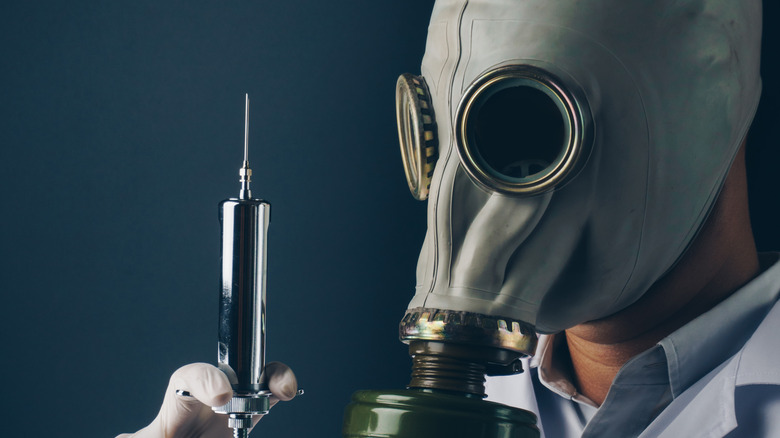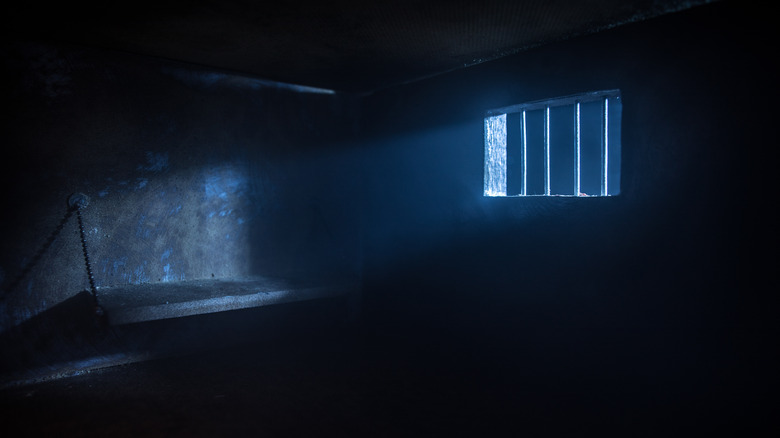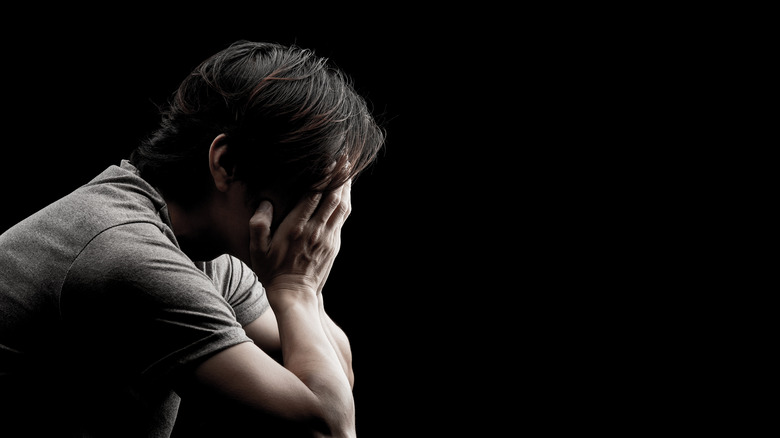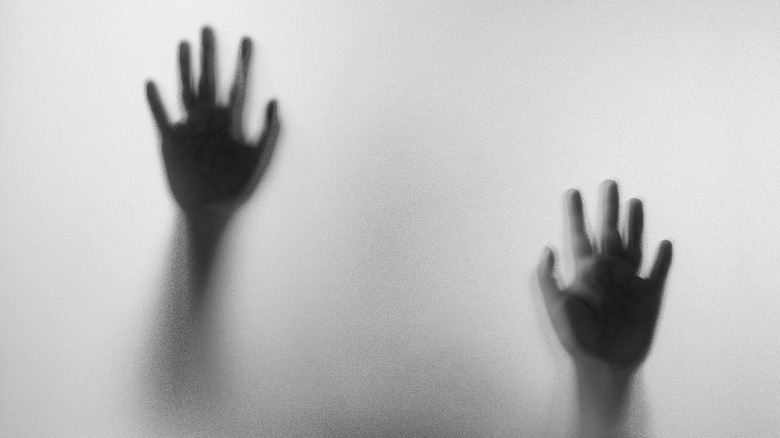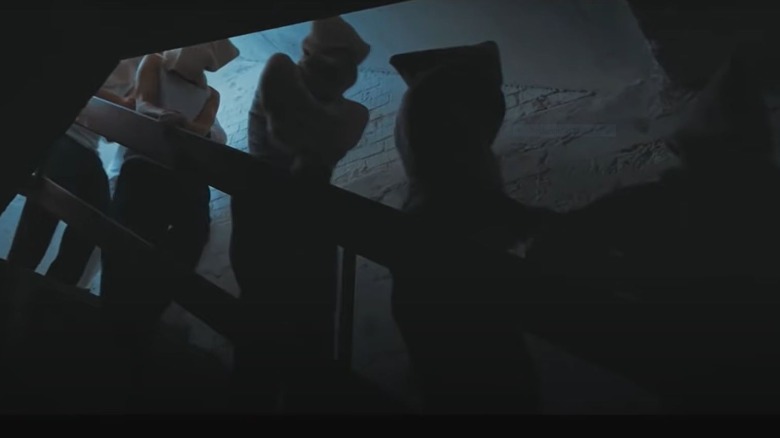How The Chilling Myth Of The Russian Sleep Experiment Turned Into An Urban Legend
This article contains graphic descriptions of graphic violence.
The phrase "Russian sleep experiment" might ring a bell for internet veterans. It might also evoke an indelible, single image: An emaciated, fiendish victim with recessed gums and horrifying fangs clutching himself on a bed in a concrete room (via iHorror). For the uninitiated, the Russian Sleep Experiment is one of the more notable creepypastas — the internet slang term for horrific urban legend-like short stories or vignettes circulated online — that folks have mistakenly taken for the truth. The tale has grown to legendary status, milling through hundreds of websites since its birth in 2010 on Creepypasta Wiki under the title "Orange Soda" (via Snopes).
Part of the viral success of the Russian Sleep Experiment centers on the specificity of detail, enough to lend itself to plausible believability. The truth of the matter is that actual Soviet experiments were often so disturbing, absurd, and sickeningly perverse that we might as well add the fictionalized version of the Russian Sleep Experiment into the mix. We're talking Frankensteining dogs, breeding human-chimpanzee hybrids to make "humanzee" super soldiers, and many, many more (via The Courier-Mail). Is it any wonder why the Russian Sleep Experiment comes across as real?
From the mind of Orange Soda
We should do a refresher for those who haven't read the Russian Sleep Experiment, available in its original form on Creepypasta Wiki. (Note that the story, which observes five test subjects locked in a prison-like Soviet-era sleep deprivation experiment, is littered with cues that it's fake.) It starts by highlighting just enough details to create a portrait of believability that makes other, later details seem true: "closed-circuit cameras," "five-inch thick glass porthole sized windows," "cots to sleep on but no bedding," etc. It then fast-forwards through the initial, more humdrum stages of the 30-day experiment to zoom in on grotesque, lovably described body-horror imagery that the writer clearly loved drafting. All these elements no doubt helped the tale gain traction.
In the story, nothing really crazy happens to the five test subjects until day five, when they start to display paranoia and aggravation about the test. The "experimental gas stimulant" used to keep them awake continues being pumped into their enclosed test chamber, and by day nine, one of the subjects starts screaming until he ruins his vocal cords. Two other guys then cover the portholes with feces to obscure sight into the room. From then on, researchers have no way of knowing what's going on inside the test chamber aside from the chamber's microphones. And so, the reader is placed in the position of the researchers, waiting for the chamber to be opened.
Worst weight loss routine ever
As the original tale on Creepypasta Wiki says, the researchers in charge of the experiment decided not to open the feces-smeared door to the sleep deprivation chamber. On the 14th-day, they used an intercom to speak to the test subjects for the first time, offering to end the experiment. A voice came back on the microphone: "We no longer want to be freed."
From this point — about halfway through the creepypasta — the Russian Sleep Experiment veers into the truly disturbing and starts to resemble grindhouse fiction. Practically the entire rest of the story is devoted to details about the various grotesqueries discovered in the testing chamber when the researchers opened it on the 15th day (at the stroke of midnight, no less). We're not going to go into some of the more nauseating descriptions, but suffice it to say the subjects engaged in cannabilism and self-evisceration, and four out of five had somehow not died. When soldiers went in to remove them from the room, the subjects fought back.
Eventually, the subjects were brought to surgery. One begged for the surgeon to "keep cutting," and they all begged for the stimulant gas, saying they "must remain awake." The last one who died told the soldier's commander, "We are you. We are the madness that lurks within you all, begging to be free at every moment in your deepest animal mind."
Birth of a creepypasta legend
So it's pretty easy to see why, in general, the Russian Sleep Experiment caught on, right? It's got just enough realistic touches, just enough over-the-top nonsense, glosses over too-technical stuff that might turn away some readers, and gets right down to what body horror fans want: blood, guts, and the lightest touch of thematic relevancy about "the darkness of human nature" or some such thing. Plus, it employs legitimate real-world connections between psychoses, drug use, and sleep deprivation, as sites like the National Institute on Drug Abuse discuss.
After it was posted in 2010 by Orange Soda, the Russian Sleep Experiment spread through the internet like wildfire. News Corp Australia summarizes how the creator of such a story, with almost near-scientific rigor and accuracy, can craft something that the public will latch onto. With the right elements of anecdotes versus overarching narrative, cliffhangers, murder, monsters or supernatural beings, unexplained phenomena, and so forth, a creepypasta is almost guaranteed to be a hit. A chart by Sara McGuire, former content editor and content marketing manager for Venngage, does a superb job of portraying all such factors. As it turns out, the Russian Sleep Experiment simply incorporated the most elements of a successful story into one, single creepypasta. Voila, instant virality.
By 2013, Snopes debunked the story, saying directly, "This account isn't a historical record of a genuine 1940s sleep deprivation research project gone awry." And yet to this day, some folks still wonder if it really happened.
Creepy pictures for creepypasta
When looking at why the Russian Sleep Experiment caught on so well, we can't discount the importance of pictures, as News Corp Australia explains. While the original creepypasta was mere white text on a gray background, somewhere along the line, someone attached a couple of clever pictures to the tale to illustrate its horror.
The most famous image associated with the story is the now-ultra-famous image we described earlier: an emaciated dude with bug eyes, recessed lips, and protruding fangs who is sitting on a bed and hunched over. Much as we hate to break the illusion, that image is just a black-and-white, fuzzy picture of a Halloween decoration you can buy at a place as mundane as Walmart, as a debunking video on YouTube explains. The prop was made by a company called Morbid Enterprises. Not to start another false tale here, but if someone from Morbid Enterprises was responsible for the original creepypasta or for circulating a picture of its product in conjunction with the story's virality, then kudos: they win the marketing game.
The other picture commonly associated with the Russian Sleep Experiment shows four guys in gas masks lined up against a wooden wall. Attentive readers will notice that the men are all wearing different masks, unlike any experimental design would necessitate. That's because the picture is a depiction of World War I gas masks from different countries: the U.S., U.K., France, and Germany.
Coming to a theater near you, again
At present, the Russian Sleep Experiment remains alive and kicking. In fact, it's developed its own cross-media cottage industry: films (on Bloody Disgusting), books (on Goodreads), fan pages (on Facebook), artwork (on Pinterest), music (on Soundcloud), video games (on Roblox), discussion threads (on Quora), you name it. We're not saying folks are obsessed with the Russian Sleep Experiment, but we're also not exactly not saying it. That being said — fingers crossed for a Russian Sleep Experiment opera.
Taking a deeper look at films, we've got a video short from 2015 (via IMDB), a teaser trailer for "The Soviet Sleep Experiment" from 2019 (on YouTube), and another 2020 trailer for a different movie dubbed "The Sleep Experiment" (also on YouTube). In 2018, iHorror reported that a movie about the Russian Sleep Experiment was on its way, but it's unclear which version they were talking about. Other websites like GeekFeed describe the same. While all those films are in English, there's also a super low-budget, 7-minute-long, 2019 indie version of the tale by an independent Russian filmmaker who, if IMDb is to believed, died "a few months" after the film premiered. It looks like "The Sleep Experiment" — apparently choosing to drop any reference to Russia — is set to premiere November 2022.
In the end, the Russian Sleep Experiment captures the imagination for what are doubtlessly revealing, disturbing reasons. And yet, this is what any good horror strives to do, if not any story, period.
